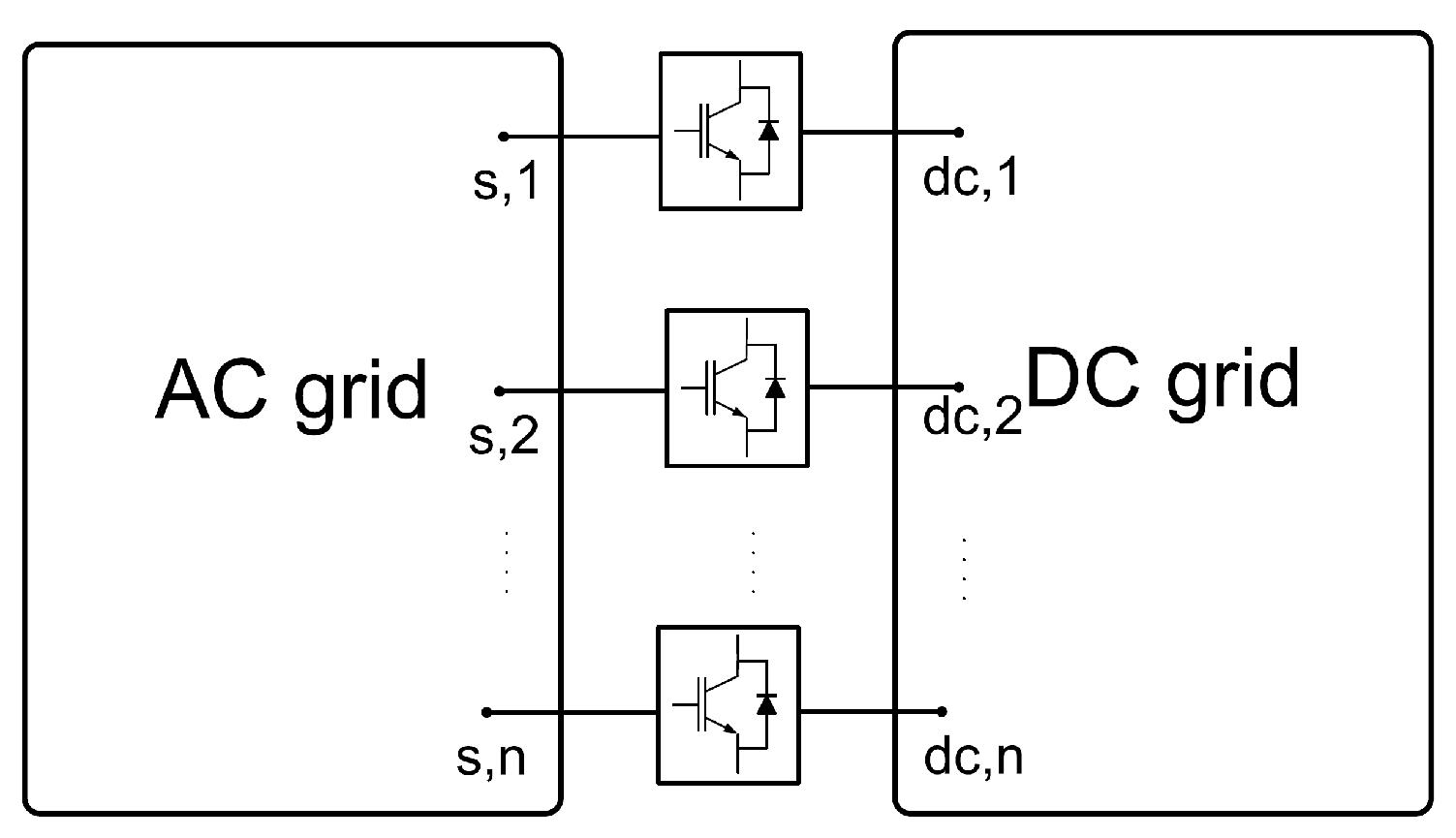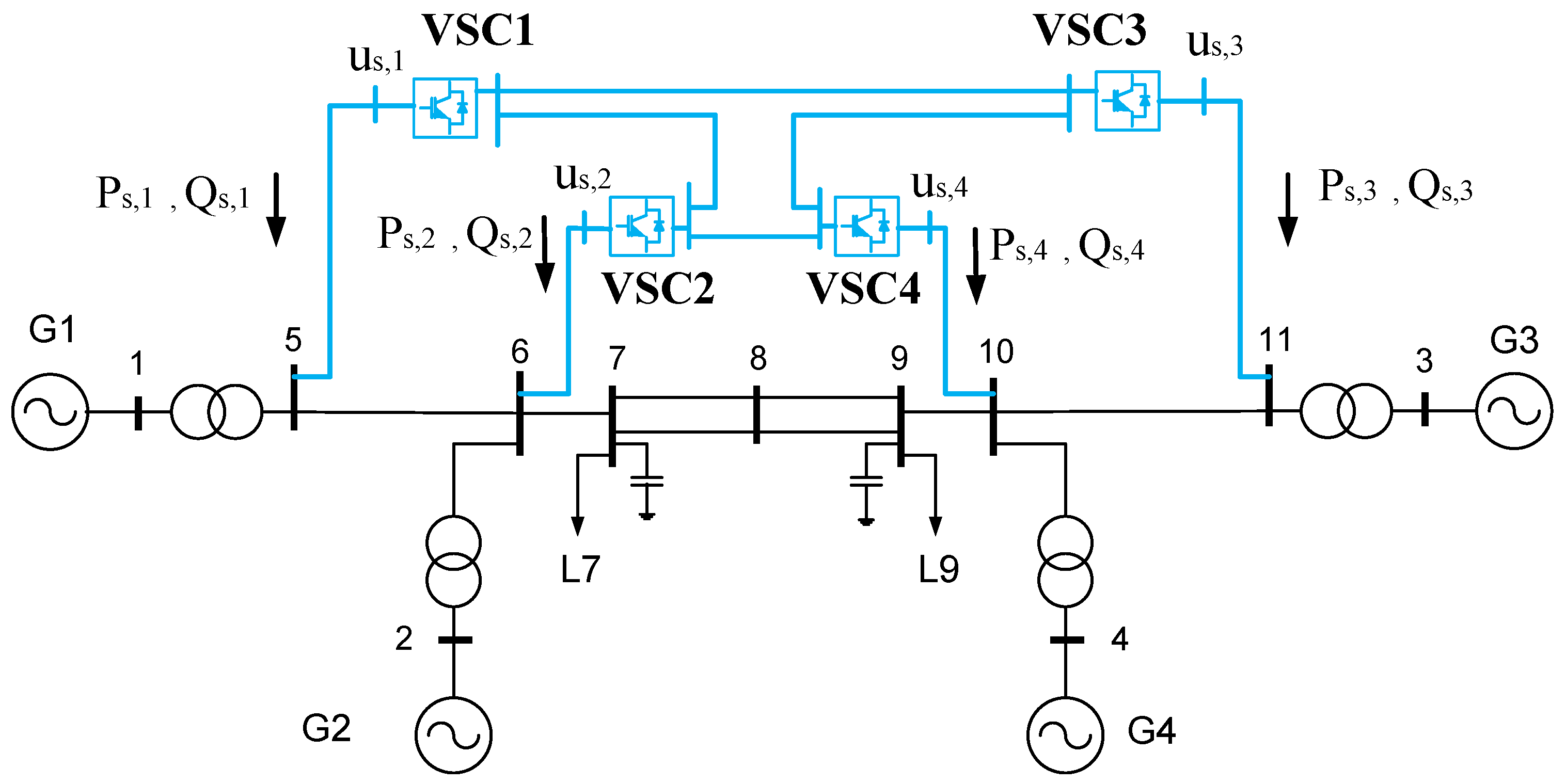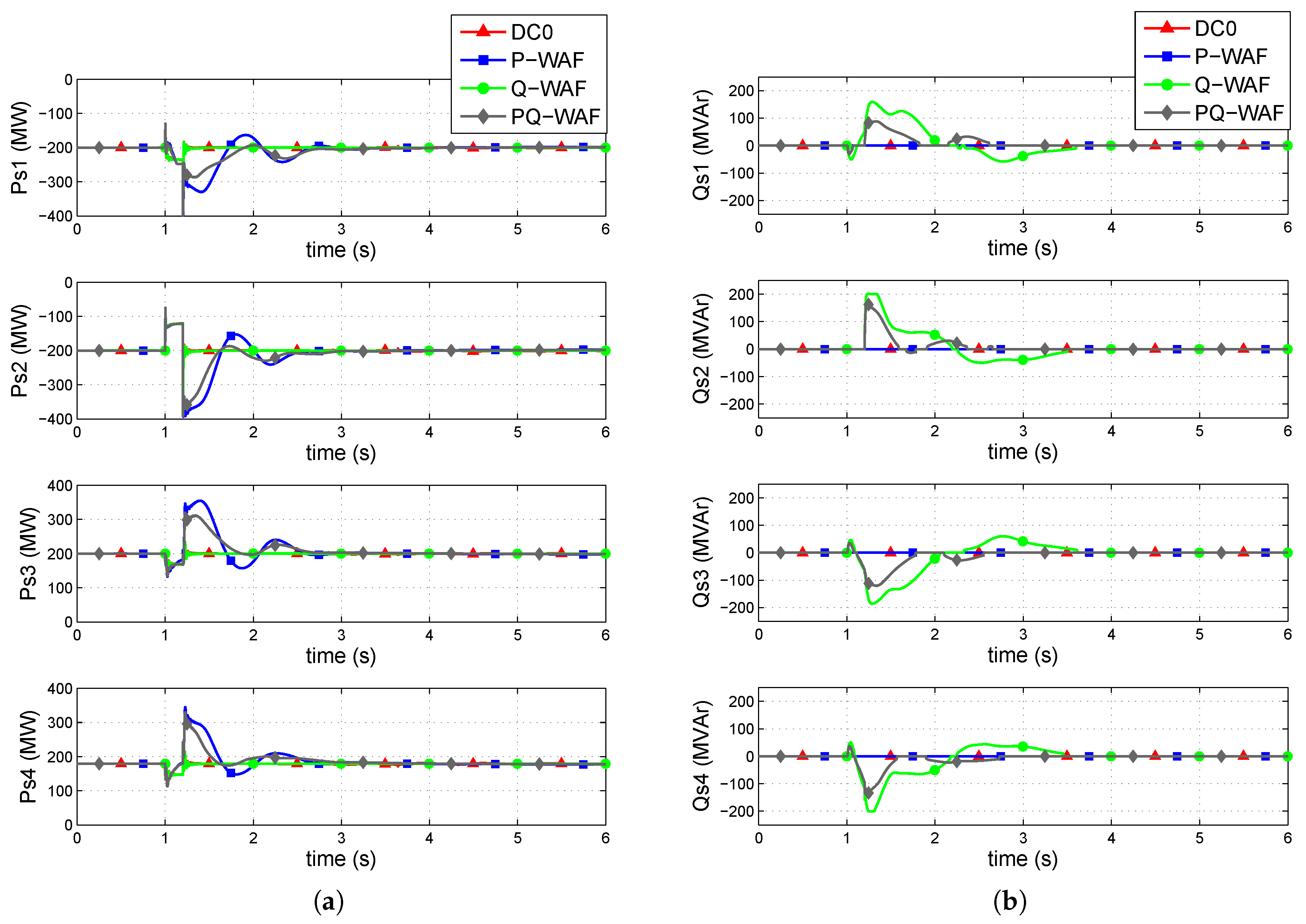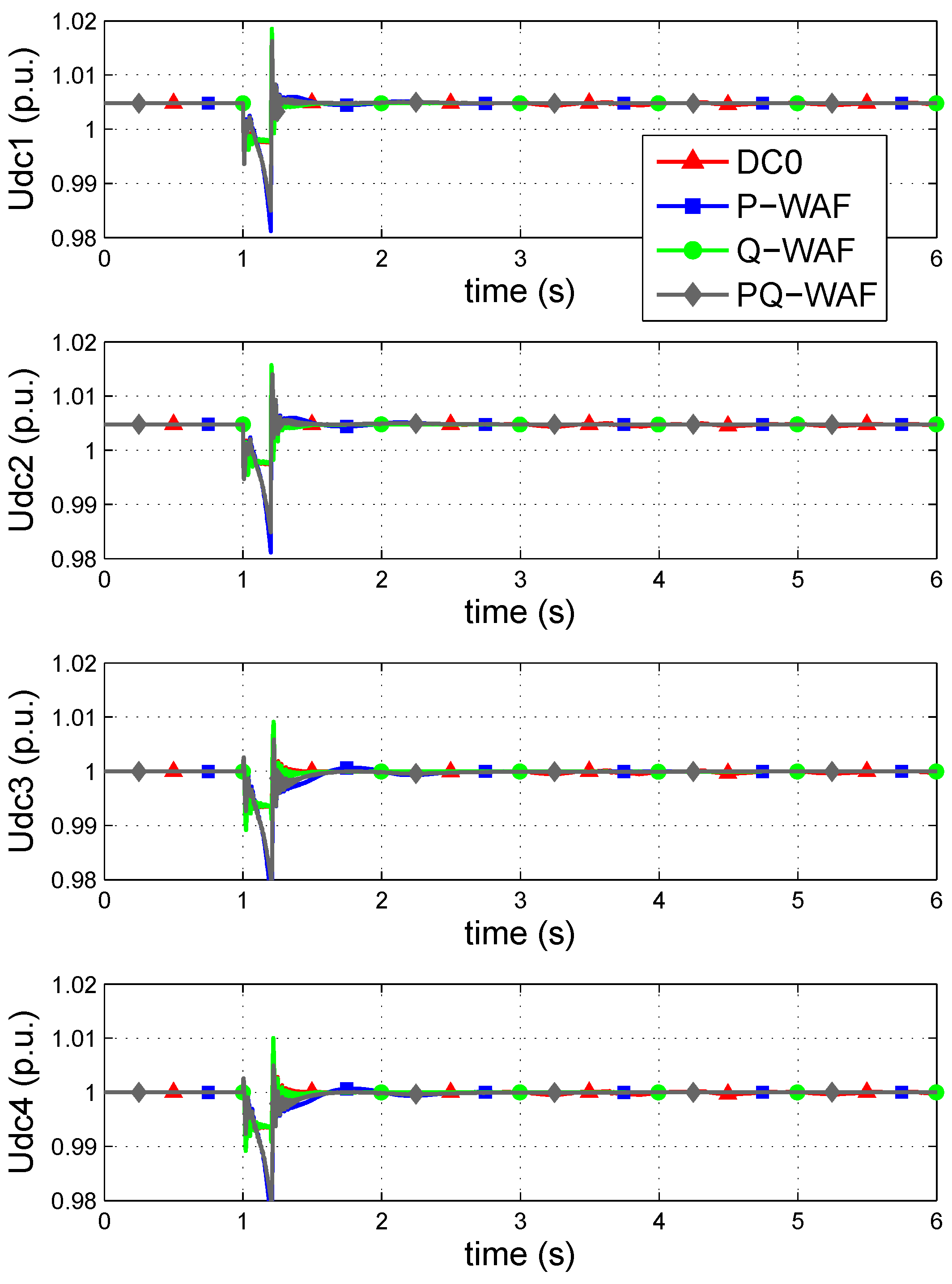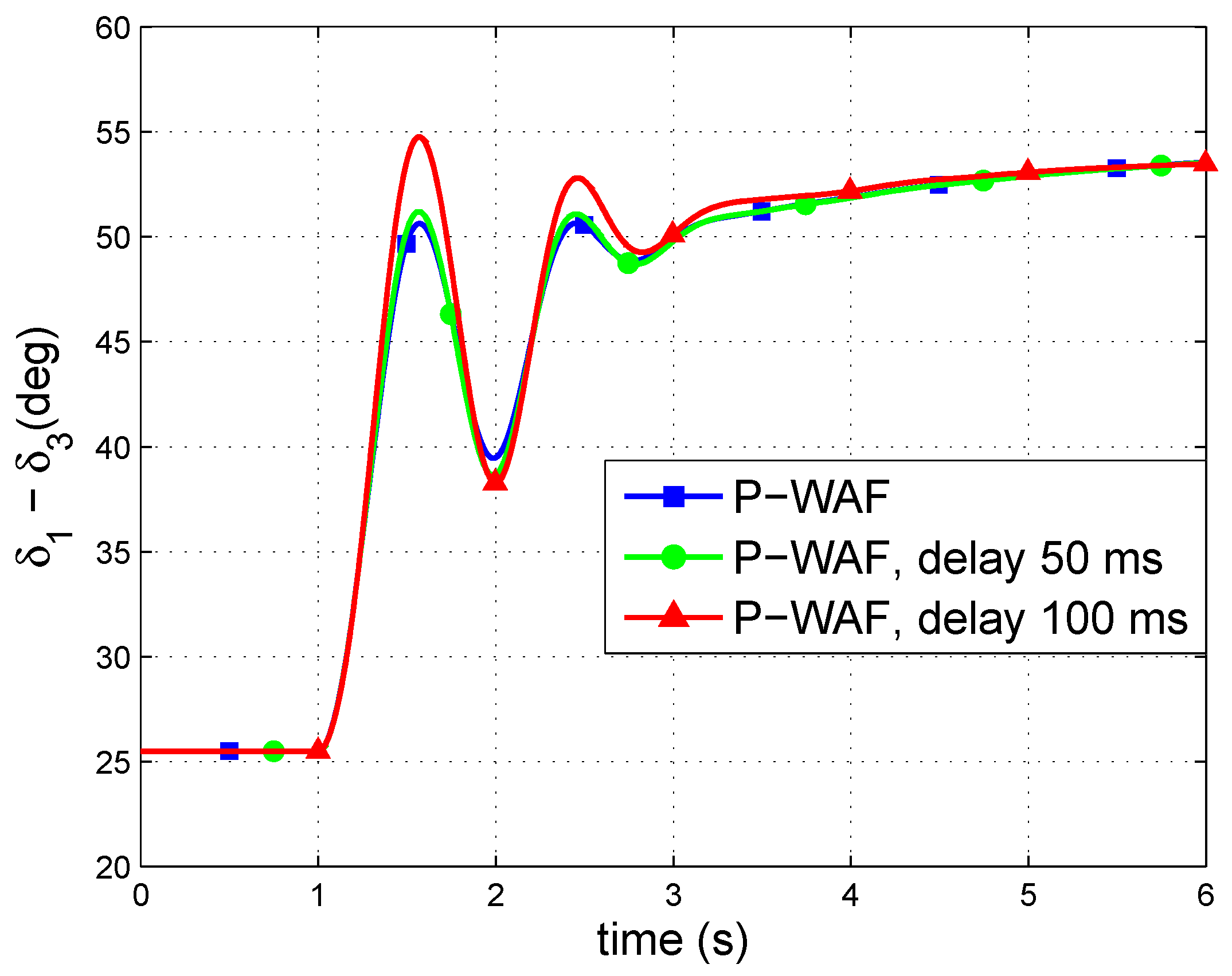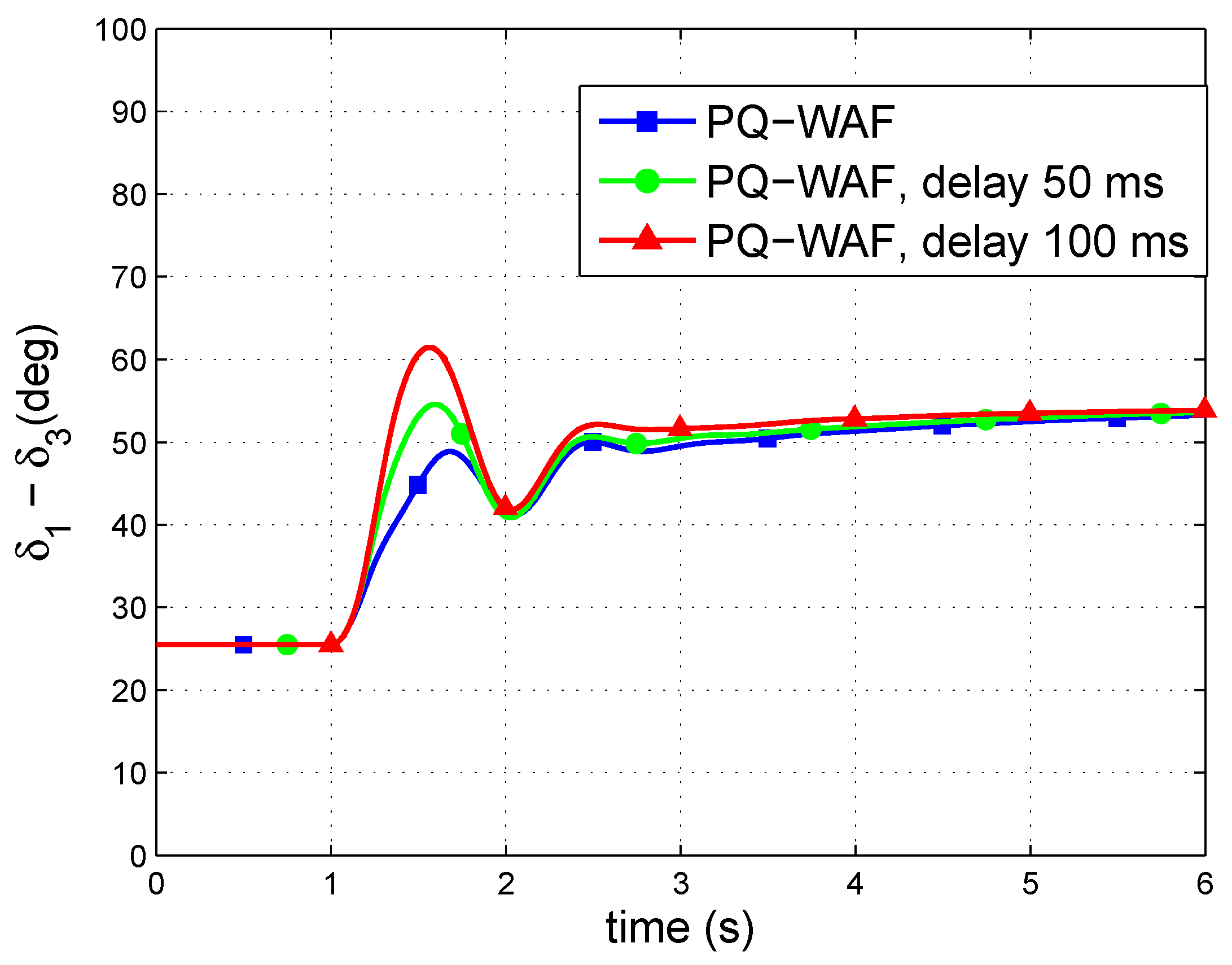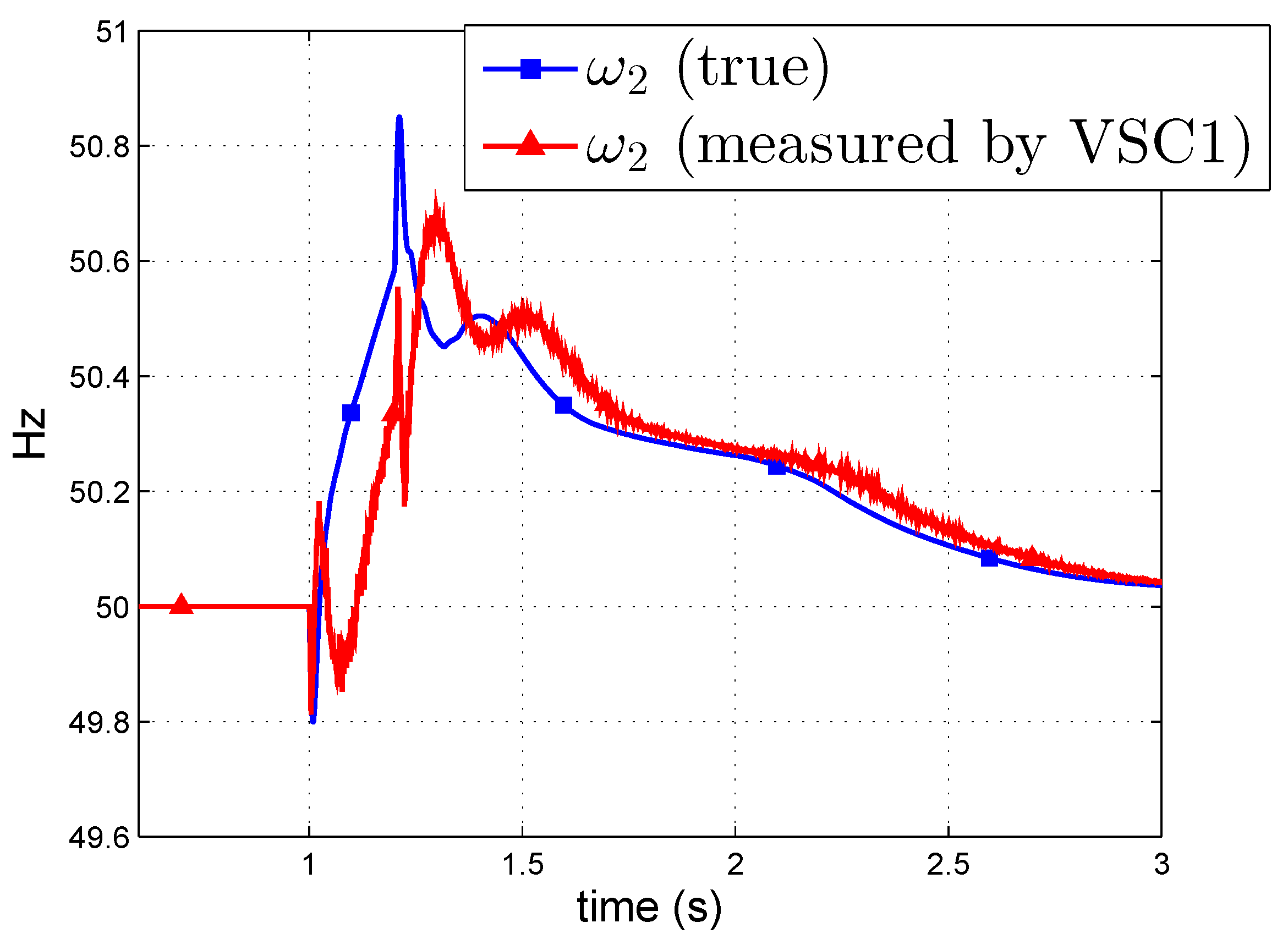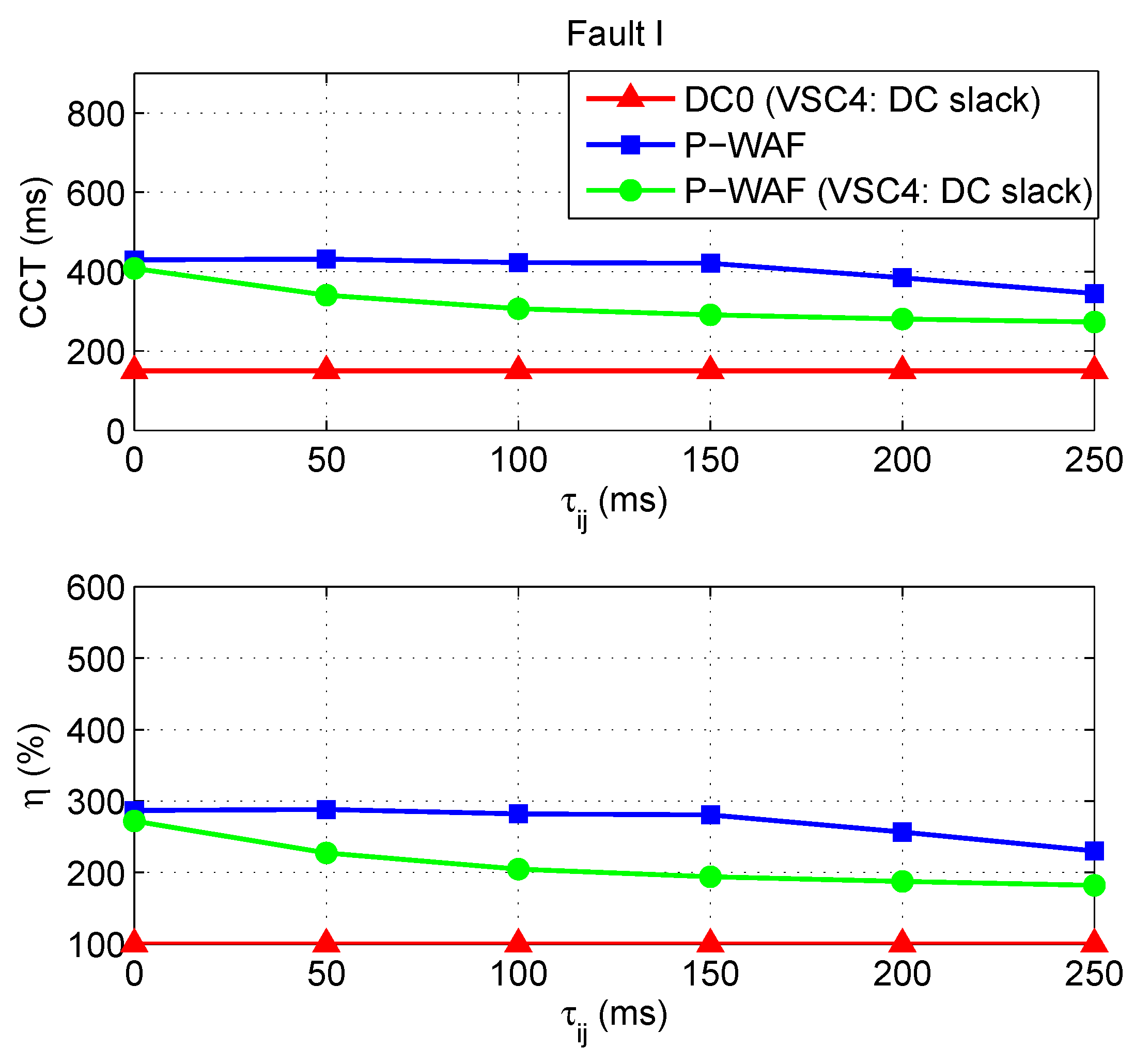1. Introduction
The main applications of high voltage direct current (HVDC) systems are: (a) transmission of large amounts of power over long overhead lines; (b) power transmission over middle-to-long isolated cables (underground or submarine cables); and (c) interconnection of asynchronous power systems. These characteristics make HVDC a key facilitating technology in several scenarios of present and future power systems. For example, almost all electrical energy systems around the world are being urged to integrate an ever-increasing number of renewable resources which are often in remote sites and will require power transmission over long distances. Hence, grid reinforcement with HVDC links is already in place in many locations and it is an attractive alternative of high voltage alternating current (HVAC) transmission in many others [
1]. Furthermore, there is a conceptual proposal for building a pan-European multi-terminal HVDC grid (the so-called “supergrid”) interconnecting several countries and connecting offshore wind energy from the North Sea [
2,
3,
4,
5]. This “supergrid” would be connected at different points to the conventional HVAC transmission system. Undoubtly, the most appropriate technology for a multi-terminal HVDC system is the one based on voltage source converters (VSC-HVDC), which has several advantages for certain applications, in comparison with the classic line commutated converter technology based on thyristors (LCC-HVDC) [
1].
Key aspects for the deployment of multi-terminal VSC-HVDC grids are converter technology, control of the voltage of the HVDC grid, HVDC breakers and HVDC protection strategies. The most recent converter technology for VSC-HVDC systems is the so-called modular multi-level converter (MMC) [
6,
7], which makes it possible to obtain output AC voltages with a very-low harmonic content. For example, MMC technology is already being used in the VSC-HVDC interconnector between France and Spain through the Catalonian Pyrenees (INELFE) [
8]. DC-voltage control in VSC-HVDC multi-terminal systems must always be guaranteed and there are different control alternatives [
9,
10]. It can be classified into: (a) centralised DC-voltage control; and (b) distributed DC-voltage control (with local DC-voltage droop control). In the former, only one converter controls the DC voltage (the DC slack), while in the latter approach, DC-voltage control is shared among the converters [
11,
12] and it is more suitable for large VSC-MTDC systems. There are also more advanced distributed DC-voltage control strategies, aiming to improve the accuracy in power sharing: the so-called pilot-voltage droop control [
13], which uses global measurements and a recent control approach based on a power sharing index [
14], in which each converter uses measurements of a nearby converter. VSC-HVDC grids need HVDC breakers to be capable to isolate faults in the HVDC grid, while maintaning the system in operation. The interruption of the current in DC is much more difficult than the interrumption of the current in AC, since the former does not pass through zero. Furthermore, HVDC breakers need to open the circuit in a few milliseconds, in order to protect the converters. The main manufacturers already have prototypes for HVDC breakers [
15,
16], although the technology is not mature yet. VSC-HVDC systems also need effective protection algorithms to detect and locate faults in the HVDC grid within milliseconds. Different protection algorithms for VSC-HVDC grids have been proposed recently [
17,
18,
19,
20,
21,
22,
23,
24,
25].
VSC-HVDC systems are very expensive and, although their main purpose will always be to facilitate power transmission overcoming the limitations of traditional HVAC systems, any additional contribution to the control and operation of power systems should be welcome. For example, several publications have already explored control strategies in point-to-point VSC-HVDC links to improve transient stability of power systems [
26,
27,
28,
29]. Transient stability (angle stability against large disturbances [
30]) margins deteriorate seriosly when long and heavily loaded HVAC lines are used. In multi-machine systems, transient stability is a global problem involving synchronism of all generators of the system and the most effective control actions to improve those margins use global measurements, such as the speed of the centre of inertia (COI) of the system [
31,
32,
33].
Recently, several control strategies for multi-terminal VSC-HVDC systems (VSC-MTDC, for short) have been proposed to improve transient stability. A supplementary control strategy for active- (P) and reactive-power (Q) injections of the VSC stations, using a linear combination of the speed deviations of the generators of the system as input signal, was proposed in [
34]. The work in [
35] proposed a bang-bang-type supplementary P controller at each VSC station, using a combination of the speed deviations of all generators of the system with respect to the speed of the COI as input signal. A sliding-mode control strategy for P injections in VSC-MTDC systems, also using the speed of the COI, was proposed in [
36]. The speed of the COI for P and Q modulation in VSC-MTDC systems is also used in the control strategy proposed in [
37]. All these control strategies require a Wide Area Measurement System (WAMS), so that each VSC can know the speeds of all generators of the system in real time. Alternatively, the work in [
38] proposed a control strategy for P injections of converter stations in VSC-MTDC systems using the average of the frequencies measured at the connection point of the VSC stations (weighted-average frequency, or WAF for short), to improve transient stability. This strategy will be referred to as P-WAF in the rest of the paper. Similarly, the WAF was used to modulate Q injections at the converter stations in VSC-MTDC systems in [
39] (strategy Q-WAF, for short), also to improve transient stability.
Although the speed of the COI seems to be the most comprehensive measurement to be used, strategies P-WAF and Q-WAF have two key advantages with respect this approach: each VSC station already measures the frequency at its AC terminals, for synchronisation purposes and a communication system within the VSC-MTDC system, only, is required.
Recent work has derived an analytical formula to approximate the bus frequencies as a linear combination of the speeds of all generators of the system [
40], proving the idea that the speeds of the generators can be observed in the bus frequencies. In fact, the speed of the COI can also be approximated as a linear combination of a set of bus frequencies of the system [
41].
Since control strategies P-WAF and Q-WAF require a communication system between the stations of the VSC-MTDC systems, their performance might be affected by communication latency. Previous work was restricted to prove that strategies P-WAF and Q-WAF could stand a reasonable communication latency. However, a detailed analysis of the impact of communication delays on these control strategies has not been reported in the literature so far. Along this line, the contributions of this paper include:
A comprehensive analysis of the impact of communication latency on strategies P-WAF (P injections of the VSC stations) and Q-WAF (Q injections of the VSC stations).
A comprehensive analysis of the impact of communication latency on simultaneous modulation of P and Q injections of the VSC stations by implementing strategies P-WAF and Q-WAF together (PQ-WAF, for short).
A detailed analysis of the impact of different tipes of communication delays on strategies P-WAF, Q-WAF and PQ-WAF.
Analysis of the impact of communication delays on strategy P-WAF, depending on the approach used for DC-voltage control in the VSC-MTDC system (a single DC-slack converter or DC-voltage droop control).
The rest of the paper is organised as follows.
Section 2 describes a suitable model for VSC-MTDC systems for electro-mechanical simulation.
Section 3 describes the proposed transient-stability-tailored control strategies in VSC-MTDC systems based on the WAF.
Section 4 presents a small case study (Kundur’s two-area test system with an embedded VSC-MTDC system) to illustrate impact of communication latency on the performance of the control strategies.
Section 5 presents the results of a larger case study (Cigré Nordic32A test system with an embedded VSC-MTDC system).
Section 6 presents the conclusions of the paper. Finally, data of the case study are provide in
Appendix A and
Appendix B.
4. Case Study 1: Kundur’s Two-Area Test System with an Embedded VSC-MTDC System
The Kundur’s two-area test system [
54] with an embedded 4-terminal VSC-MTDC system was used for simulation (
Figure 7). Data are detailed in
Appendix A. Converter stations were operated with DC-voltage droop control and reactive-power control. Simulations were carried out in PSS/E software [
46], with the VSC-MTDC model presented in [
44].
The initial operating point of the VSC-MTDC system was calculated running an AC/DC power flow, with the following specified variables:
VSC1: MW and MVAr.
VSC2: MW and MVAr.
VSC3: MW and MVAr.
VSC4: p.u and MVAr (VSC4 is used as the DC-slack converter for power-flow calculation).
The following cases have been analysed and compared:
DC0: No supplementary control strategy in the VSC stations.
Strategy P-WAF (P injections of VSC stations).
Strategy Q-WAF (Q injections of VSC stations).
Strategy PQ-WAF (simultaneous modulation of P and Q injections of VSC stations).
4.1. Control Strategies
To start with, the performance of the control strategies was analysed, without communication delays, in order to illustrate the ideally achievable results.
4.1.1. Fault simulation
A three-phase-to-ground short circuit at line 7–8 a (close to bus 7) has been simulated. The fault is cleared after 200 ms by disconnecting the faulted circuit.
Figure 8 shows the angle difference between generators 1 and 3. Generators lose synchronism when the VSC stations do not have any supplementary control strategies implemented (DC0), while synchronism is maintained with control strategies P-WAF, Q-WAF and PQ-WAF. Strategies P-WAF and PQ-WAF show better damping of the first swing of the angle difference than strategy Q-WAF.
In order to fully understand the effect of the proposed control strategies, the frequencies measured at the VSC stations (
), the WAF (
) and the frequency deviations with respect to the WAF (
) are shown in
Figure 9 for strategy P-WAF. Strategies Q-WAF and PQ-WAF show a similar pattern. During the short circuit, all synchronous machines of the system accelerate and all frequencies measured at the VSC stations rise. Nevertheless, some frequencies increase more than others. For example, during the fault and immediately after the fault clearance, frequencies measured by VSC1 and VSC2 are above the WAF, while frequencies measured by VSC3 and VSC4 are below the WAF.
Figure 10 shows active- and reactive-power injections of the VSC stations into the AC grid, respectively. Without supplementary control (DC0), P and Q injections remain constant. In strategy P-WAF, P injections are modulated during the transient: immediately after the fault clearance, VSCs 1 and 2 reduce their P injections, since the frequencies measured by those converters are above the WAF. On the contrary, VSCs 3 and 4 increase their P injections, since their frequencies are below the WAF. In strategy Q-WAF, VSCs 1 and 2 increase their Q injections immediately after the fault clearance, while VSCs 3 and 4 reduce their Q injections. In strategy PQ-WAF, both, P and Q injections, are modulated simultaneously and this is why control effort is lower than the one in P-WAF and Q-WAF. By modulating P and Q injections of the VSC stations with strategies P-WAF, Q-WAF and PQ-WAF, the angles of generators are pulled together and transient stability is improved. Finally,
Figure 11 shows the DC voltages of the converter stations, which remain close to 1 p.u. during the simulation.
4.1.2. Critical Clearing Times
The critical clearing time (CCT) is defined as the maximum time that a fault can remain before been cleared, without producing loss of synchronism and it is normally used as an indicator of a transient stability margin. The CCTs of the faults described in
Table 1 are compared in
Table 2, concluding that control strategies P-WAF, Q-WAF and PQ-WAF increase the CCTs significantly, with respect to the base case (DC0).
4.2. Impact of Communication Latency
The effect of latency on the frequencies measured by each VSC station to calculate the WAF in Equation (
5) has been investigated. Each converter
i will have a delay
(zero delay applied to its own frequency measurement) and
(non-zero delay applied to the frequency measurements of the rest of VSC stations), when calculating the WAF.
4.2.1. Strategy P-WAF
The same fault as in
Section 4.1.1 was simulated (Fault I of
Table 1 cleared after 200 ms). Strategy P-WAF was implemented and the frequency signals were used by each converter to calculate the actual WAF communication latency. The following cases will be compared:
Strategy P-WAF, without communication latency ( ms).
Strategy P-WAF, with a communication latency of 50 ms ( ms and ms if ).
Strategy P-WAF, with a communication latency of 100 ms ( ms and ms if ).
First of all, the impact of the communication delay on frequency measurements is illustrated:
Figure 12 shows the true frequency at the AC terminal of VSC2 and the frequency of VSC2 measured by VSC1 when calculating the WAF, with a communication delay of
ms. Clearly, VSC1 sees the frequency of VSC2 delayed.
Results obtained with strategy P-WAF, with zero delay,
ms and
ms are shown in
Figure 13 and
Figure 14, respectively. The larger the communication delay is, the larger the generator-angle difference during the first swing is. However, the impact of communication latency on control strategy P-WAF is remarkable small and similar results are obtained in comparison to the case without communication latency. Notice that the time response of the P injections are very similar in the three cases (
Figure 14a). This is due to the fact that strategy P-WAF and the DC-voltage droop are implemented together in all converter stations. Communication latency produces
, provoking DC-voltage fluctuations during the fault and immediately after its clearence (
Figure 14b). These DC-voltage fluctuations are compensated with power sharing among all VSC stations thanks to the beneficial effect of the DC-voltage droop control implemented.
4.2.2. Strategy Q-WAF
Fault I of
Table 1, cleared after 200 ms, was simulated. The following cases are compared:
Strategy Q-WAF, without communication latency ( ms).
Strategy Q-WAF, with a communication latency of 50 ms ( ms and ms if ).
Strategy Q-WAF, with a communication latency of 100 ms ( ms and ms if ).
Figure 15 shows the generator-angle differences, while
Figure 16 shows Q injections of the VSC stations. Q-WAF clearly deteriorates with communication latency. This effect is more noticeable than when using strategy P-WAF. However, synchronism is maintained in all three cases. Q modulation with communication latency differs from the one with
ms (
Figure 16). Notice that, in the presence of communication latency, Q injections of VSCs 1 and 2 reach their limits (200 MVAr) during the fault and immediately after the fault clearance (
Figure 16). The plots of P injections and DC voltages are omitted, since reactive-power control is independent of power sharing and DC voltages of the VSC-MTDC system.
4.2.3. Strategy PQ-WAF
The effect of communication latency on strategy PQ-WAF was also analysed. Again, Fault I of
Table 1, cleared after 200 ms, was simulated. The following cases are compared:
Strategy PQ-WAF, without communication latency ( ms).
Strategy PQ-WAF, with a communication latency of 50 ms ( ms and ms if ).
Strategy PQ-WAF, with a communication latency of 100 ms ( ms and ms if ).
Figure 17 shows the generator-angle differences. Results deteriorate with communication latency although stability is maintained in all three cases. The rest of the plots are omitted (P injections, Q injections and DC voltages), since they do not help understanding the system performance.
4.2.4. Critical Clearing Times
Table 3 shows the CCTs for the faults of
Table 1, obtained with strategies P-WAF, Q-WAF and PQ-WAF, with communication latency of 50 ms and 100 ms. This case is called Case A, for further comparison with other cases in
Section 4.3. The CCTs of all faults decrease as the communication latency increases, for all the control strategies. As already discussed, the impact of communication latency is more noticeable in strategy Q-WAF (Q injections) than in strategy P-WAF (P injections). The CCTs for all faults, obtained with the three control strategies and with a communication latency of 100 ms, are significantly higher than those obtained in the base case (DC0).
Finally,
Figure 18 shows the CCT for Fault I versus communication-latency delay (
) (from 0 ms to 250 ms, using a step of 50 ms). The CCT of the base case (DC0) is included in
Figure 18 for comparison purposes. An indicator
is also plotted in
Figure 18, which is defined as the CCT obtained with a certain control strategy divided by the CCT obtained in the base case:
As
increases, the CCTs obtained with strategies Q-WAF and PQ-WAF decrease faster that the CCT obtained with strategy P-WAF (
Figure 18). Notice that, in all three strategies, the CCTs obtained with
ms are greater than the CCT obtained in the base case (DC0). Therefore, strategies P-WAF, Q-WAF and PQ-WAF proved to be robust against communication latency (see the percentage values of
in
Figure 18).
4.3. Further Analysis of the Impact of Communication Latency: Equal versus Different Delays in the Communication Channels
A communication system between the VSC stations can be implemented in several ways. For example, frequency measurements at the AC side of all VSC stations can be collected by a central controller in order to be later distributed so that each converter can calculate the WAF according to Equation (
5). Alternatively, each VSC station could be communicated directly with the others. Different communication arrangements will produce different latency patterns. There are two key aspects of communication latency that could affect the performance of the control strategies:
Total communication delay for frequency measurements at the VSC stations: having a delayed WAF instead of its true value.
Different communication delays for frequency measurements at the VSC stations: having a perturbed WAF instead of its true value, caused by different values of the communication delays of each frequency measurement.
The robustness of control strategies P-WAF, Q-WAF and PQ-WAF has been analysed in the following three cases:
Case A: Equal delay for all frequency measurements:
ms, 100 ms, if
, except for the frequency measured at the VSC station that calculates the WAF, that has zero delay (
ms) (this is the case analysed in
Section 4.2). This case represents a communication system where frequency measurements at the VSC-MTDC systems are collected by a central controller and sent to each VSC station. Each VSC station uses those measurements to calculate the WAF.
Case B: Equal delay for all frequency measurements: ms, 100 ms, . This case represents a communication system where frequency measurements at the VSC-MTDC systems are collected by a central controller and the central controller calculates the WAF, which is send, later, to all VSC stations.
Case C: Different delays for frequency measurements:
is obtained as a random number in the range
, following a uniform distribution (
). The values of the delays are maintained constant during the simulation. Two values of
are used: 50 ms and 100 ms. Samples obtained for
are given in
Table 4. This case represents a communication system with communication channels between all the VSC stations.
Case D: Stochastic delays for frequency measurements: At each time step, the delay
is obtained as a random number following a triangular distribution with mean
and upper/lower limits
. The probability density function of the triangular distribution of
is shown in
Figure 19. Hence, the delay will be within the range:
As in case A, the frequency measured at the VSC station that calculates the WAF will have a zero delay (
ms). Two delays will be tested:
ms and
ms. Stochastic delays introduce noise, as shown in
Figure 20. This case represents a more realistic version of Case A.
CCTs for the faults of
Table 1 obtained in cases A, B, C and D are reported in
Table 3 of
Section 4.2 and
Table 5,
Table 6 and
Table 7 respectively. In the four cases, CCTs decrease as the communication latency increases and, again, communication latency have a greater impact on strategy Q-WAF than on strategy P-WAF. Nevertheless, even in the presence of communication latency CCTs obtained with the control strategies outperform those obtained in the base case (DC0). Furthermore, no significant differences are observed in cases A (equal delay for all frequency measurements except for the frequency of the VSC station that calculates the WAF, that has
ms), B (equal delay for all frequency measurements), C (different delays for frequency measurements) and D (stochastic delays for frequency measurements). Moreover, notice that the results of case A (
Table 3 of
Section 4.2) and case D (
Table 7) are practically the same. This proves that the control strategies are robust against noisy delays and this is due to the low-pass filter used in the control schemes (
in
Figure 4 and
Figure 5).
4.4. Further Research on the Impact of Communication Latency on Strategy P-WAF with Centralised DC-Voltage Control
So far, strategy P-WAF has been implemented in all VSC stations together with DC-voltage droop control (distributed DC-voltage control). As proved in
Section 4.2.1, the presence of the latter mitigated the impact of communication latency. This Section investigated the case in which a DC-slack converter controls its DC voltage (centralised DC-voltage control) and all other converters control their P injections according to strategy P-WAF, only (there is not DC-voltage droop control). When modulating P injections in a VSC-MTDC system with centralised DC-voltage control, overloading of the DC-slack converter should be avoided.
Tests reported in this Section have been carried out within the following scenario:
VSC4 controled its DC voltage to 1 p.u (DC slack).
VSCs 1, 2 and 3 controled their P injections, using strategy P-WAF. Saturation parameters of the supplementary controller were set to p.u., in order to avoid overloading of the DC slack converter.
VSC2 was given the role of DC-slack converter, with DC-voltage limits p.u. and p.u.
DC-voltage limits of VSCs 1 and 3 were set to p.u. and p.u., in order to avoid interactions in case that the DC slack is overloaded.
Fault I of
Table 1, cleared after 200 ms, was simulated and the following cases were compared:
Strategy P-WAF (with VSC4 as DC slack), without communication latency ( ms).
Strategy P-WAF (with VSC4 as DC slack), with a communication latency of 50 ms ( ms and ms if ).
Strategy P-WAF (with VSC4 as DC slack), with a communication latency of 100 ms ( ms and ms if ).
Figure 21 shows the generator-angle difference. Transient stability deteriorates with communication latency and the impact of the communication delay is more noticeable than when using strategy P-WAF together with DC-voltage droop control. Nevertheless, synchronism is maintained in all cases.
Figure 22 shows P injections of the VSC stations and DC voltages. VSC stations 1, 2 and 3 modulate their P injections, while VSC4 controls its DC voltage to 1 p.u. Voltages at all DC buses are close to 1 p.u. during the whole simulation.
The CCTs for the faults of
Table 1 are shown in
Table 8. As the communication delays increase, the CCTs decrease. Regardless of the communication latency, CCTs are significantly higher than those obtained in the base case (DC0, with VSC4 as DC slack). Finally,
Figure 23 shows the CCT and indicator
of Fault I as a function of communication latency. The same scale of
Figure 18 is used, to facilitate the comparison of the results. The CCT obtained with strategy P-WAF (and DC-voltage droop) is also plotted. In this case, the CCT of Fault I decreases as the communication delay increases, faster than in the case of P-WAF together with the DC-voltage frequency droop. The CCT obatined for
ms is much higher than the one obtained in the base case.
Results show that strategy P-WAF, when implemented in a VSC-MTDC with centralised DC-voltage control (a single DC slack converter), is robust against communication latency although better results are obtained when implementing strategy P-WAF together with DC-voltage droop control.
5. Case Study 2: Cigré Nordic32A Test System with an Embedded VSC-MTDC System
The Cigré Nordic32A test system [
55] with an embedded 3-terminal VSC-MTDC system was used for simulation (
Figure 24). The objective of using this system is to test the control strategy in a larger multi-machine system, in order to test the scalability of the conclusions. Data are detailed in
Appendix B. Converter stations were operated with DC-voltage droop control and reactive-power control. Simulations were carried out in PSS/E software [
46], with the VSC-MTDC model presented in [
44].
The initial operating point of the VSC-MTDC system was calculated running an AC/DC power flow, with the following specified variables:
VSC1: MW and MVAr.
VSC2: MW and MVAr.
VSC3: p.u and MVAr (VSC3 is used as the DC-slack converter for power-flow calculation).
The following cases have been analysed and compared:
DC0: No supplementary control strategy in the VSC stations.
Strategy P-WAF (P injections of VSC stations).
Strategy Q-WAF (Q injections of VSC stations).
Strategy PQ-WAF (simultaneous modulation of P and Q injections of VSC stations).
Since a detailed analysis has been presented in
Section 4, this section will focus on the main results, only. The CCTs of the faults described in
Table 9 have been calculated. Fault I is the most severe one, since corridor 4031–4041 carries a large amount of power in the operating point considered and both circuits of the corridor are disconnected after the fault clearing.
The performance of control strategies P-WAF, Q-WAF and PQ-WAF has been tested in the following three cases:
Case A: Equal delay for all frequency measurements: , except for the frequency measured at the VSC station that calculates the WAF, that has zero delay ( ms).
Case B: Equal delay for all frequency measurements: .
Case C: Different delays for frequency measurements:
is obtained as a random number in the range
, following a uniform distribution (
). The values of the delays are maintained constant during the simulation. Two values of
are used: 50 ms and 100 ms. Samples obtained for
are provided in
Table 10.
Case D: Stochastic delays for frequency measurements: At each time step, the delay
is obtained as a random number following a triangular distribution with mean
and upper/lower limits
. The probability density function of the triangular distribution of
is shown in
Figure 19. The frequency measured at the VSC station that calculates the WAF will have a zero delay (
ms). Two delays will be tested:
ms and
ms.
Table 11,
Table 12,
Table 13 and
Table 14 report the CCTs obtained for the faults of
Table 9, for cases A–D. Without communication latency, control strategies increase the CCTs significantly. For example, the CCT of Fault I increases from 105 ms in the base case DC0 to 390, 370 and 404 ms, with control strategies P-WAF, Q-WAF and PQ-WAF, respectively. The three control strategies proved to be robust against communication latency. Results with control strategies P-WAF and PQ-WAF are similar to those obtained without communication latency. As already discussed, communication latency have more impact when modulating reactive-power injections (Q-WAF). For example, with communication delays of 50 ms and 100 ms in case A (
Table 11), the CCTs of Fault I are 317 ms and 160 ms, respectively. Those results still improve the base case (CCT of 105 ms), but below the improvement without communication latency (CCT of 370 ms). The CCTs of cases A–D (
Table 11,
Table 12,
Table 13 and
Table 14) follow a similar pattern and there are no signicant differences regarding the impact of the different type of delays considered.
Faults III and IV are also interesting to discuss. Fault III is almost unaffected by the control strategies and its CCT cannot be improved. The impact of strategy Q-WAF on Fault IV has a surprising pattern, since its CCT increases as the communication latency increases (when using Q-WAF). This was already observed in [
39].
Finally,
Figure 25 shows the CCT and
of Fault I (the most severe and challenging fault) as a function of communication latency of Case A. Control strategies P-WAF and PQ-WAF present significant improvements, even for large communication delays. In fact, the CCTs obtained are very similar to those obtained without communication delays. The performance of strategy Q-WAF worsens much faster as the value of the communication delay increases. Furthermore, for communication delays of
ms and
ms, the performance of strategy Q-WAF is very poor and results are worse than in the base case (a CCT of 0 ms means that the tripping of lines 4031-4041a&b produces loss of synchronism, even if there is no solid short circuit). This implies that control strategy Q-WAF requires fast communication systems to be effective (delays should not be greater than 100 ms).

